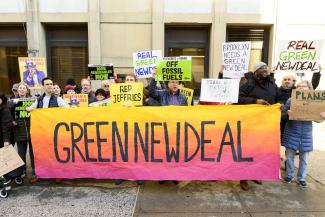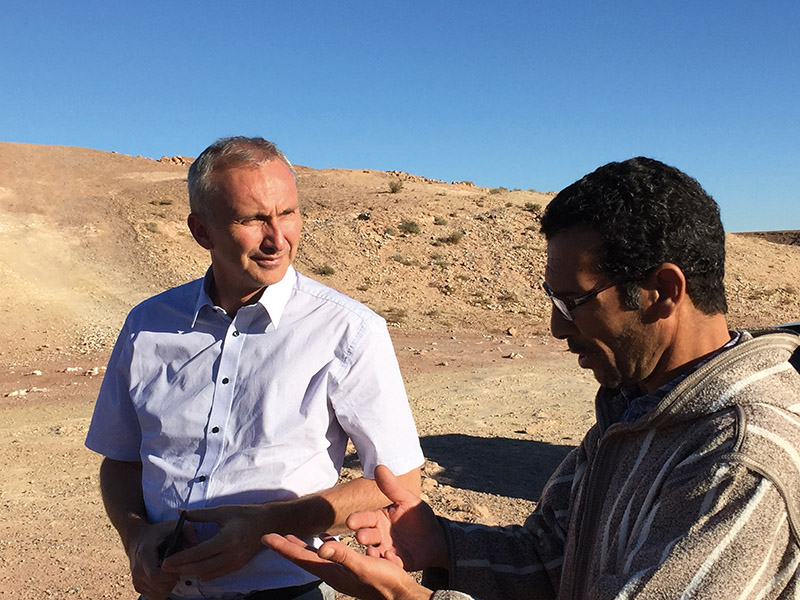Blog
Early signs of paradigm change

The Green New Deal has not been precisely defined so far. The rough outlines are clear however. The goals are to transform the US economy radically in order to make it environmentally sustainable and socially inclusive. The basic idea is to achieve these things by boosting government spending on eco-friendly infrastructure, related jobs and skills training. The scope of the challenges ahead would guarantee full employment, Green New Deal proponents reckon.
The name “Green New Deal” obviously points to the historic example of Franklin D. Roosevelt, the US president who led the nation out of the Great Depression of the 1930s and whose assertive economic policies helped it to prevail in World War II. In the dramatic slump after the stock market crash of 1929, he promised Americans “a new deal”. Given that the economy lacked sufficient private-sector investments to grow, Roosevelt opted for massive state-funded infrastructure investments. Moreover, he started social-protection programmes to ensure that elderly and disabled poor people did not live in misery.
Democratic policymakers have launched a document outlining what they want the Green New Deal to do. It includes universal health care, free college and promotion of minorities. That fits the Roosevelt model, but goes beyond environmental issues. Anyway, the paper is still too vague for immediate legislation. Debate will go on, and for the purpose of this blogpost, I will stick to the narrower environmental meaning of Green New Deal.
In any case, Roosevelt’s New Deal fast stimulated new economic activity. Private-sector companies started expanding capacities again. They noticed that they were able to sell additional output because purchasing power had increased again. The New Deal thus restored investor confidence. That it was funded with budget deficits did not matter.
The government’s role in the economy became even bigger in the war. Industries were increasingly geared to military needs, with the federal budget bearing the costs. Government lending kept increasing. The huge public debt, however, did not lead to serious bottlenecks even after the war. The reason was fast growth for the next few decades. Accordingly, the New Deal debt accounted for an ever smaller share of GDP.
Policymakers of the Democratic Party now want to tackle the environmental crisis in a similar way. One big difference, of course, is that, in the Roosevelt era, nobody worried about the global environment. Another big difference is that public policy today is not guided by the exigencies of a World War. Proponents of the Green New Deal point out, however, that climate change is as urgent a challenge as Nazi Germany and Imperial Japan were in the 1940s.
They make sense. Even the Trump administration admits that global warming will reduce economic output in the USA by more than $ 5 trillion by the end of this century. Given that we know the costs of climate change will be huge, we would be well-advised to invest heavily in preventing or at least mitigating the damages now. And no, there is nothing wrong with using loans to finance measures now if they prevent huge costs in the future. Interest rates are currently very low anyway.
Democrats correctly point out that Donald Trump’s tax cuts increased the national deficit dramatically, and they argue that fighting climate change and improving social inclusion are more worthy goals than reducing rich people’s tax burden. It is worth emphasising, moreover, that the current scenario resembles the 1930 in an important way: Investor confidence in real-economy opportunities is very low. There is a lack of good business ideas. One consequence is weak demand for cred, so interest rates are very low. Stock markets and the financial sector in general are focused on nominal, short-term rewards, not on long-term investments. A government-triggered expansion of eco-friendly sectors might well make a difference and lead to a self-propelling dynamic.
The proponents of the Green New Deal definitely want a strong state. To them, low taxes are not what matters most. Alexandria Ocasio-Cortez, the young congresswoman from New York who is currently the rising star among Democrats, has proposed a marginal tax rate of 70 % on all incomes above an annual $ 10 million for financing the Green New Deal. Elizabeth Warren, a senator who wants to become the Democratic nominee for the next presidential election, has proposed a wealth tax.
Until very recently, such ideas would have been considered absurd. Today, they are taken seriously. Part of the reason is that US citizens increasingly worry about climate change. The president and leading Republicans may still deny it is happening, but people are aware of the impacts nonetheless. Hurricanes, wildfires and unprecedented cold spells are causing serious suffering. And yes, most US citizens understand that climate change means more cases of extreme weather, not a linear increase of temperatures.
Though the debate has changed in Washington, the national policies will not do so soon. As long as Donald Trump is in the White House and Republicans control the Senate, no kind of Green New Deal will be implemented. At this point, however, it looks unlikely that Trump will be re-elected, and after him, change may come very fast.
Market-orthodox conservatives seem to be losing an important battle, according to The Economist. The London-based magazine has always taken climate change seriously, but as the standard bearer of free-market ideology, it keeps promoting solutions such as taxing carbon emissions or cap-and-trade programmes. Such measures would, in theory, be a clever way to factor the environmental side-effects of market transactions into those market transactions, thus providing incentives for making more environmentally friendly choices. Such schemes have been discussed again and again for decades. So far, they have not really helped to limit global warming. The environmental crisis has only become worse.
The Economist argues that, when markets fail, government action is warranted. In view of risks that threaten humanity as a species, action of a scale that resembles a war effort would make sense. We must get a grip on the problems.
Free-market ideologues should not fear that this would be the end of capitalism. Roosevelt’s New Deal did not eradicate the market economy, but saved it. It restored growth when market forces had led into a downward spiral. It is noteworthy in this context, that Green New Deal proponents in the USA today are not proposing to nationalise key industries or adopt any other Marxist approaches. Some may call themselves Democratic Socialists, but they don’t want to abolish markets. They want to make them serve the common good. The model is Denmark, not Venezuela or the Soviet Union.
P.S.: The term “Green New Deal” has actually been around for about a decade. The UNDP has used it, and so have Germany’s Green Party and indeed Democrats in the USA. However, the idea did not gain much traction. I wish it had. The world might now be a safer place.















